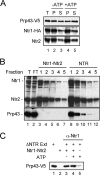Dynamic interactions of Ntr1-Ntr2 with Prp43 and with U5 govern the recruitment of Prp43 to mediate spliceosome disassembly
- PMID: 17893323
- PMCID: PMC2169193
- DOI: 10.1128/MCB.01213-07
Dynamic interactions of Ntr1-Ntr2 with Prp43 and with U5 govern the recruitment of Prp43 to mediate spliceosome disassembly
Abstract
The Saccharomyces cerevisiae splicing factors Ntr1 (also known as Spp382) and Ntr2 form a stable complex and can further associate with DExD/H-box RNA helicase Prp43 to form a functional complex, termed the NTR complex, which catalyzes spliceosome disassembly. We show that Prp43 interacts with Ntr1-Ntr2 in a dynamic manner. The Ntr1-Ntr2 complex can also bind to the spliceosome first, before recruiting Prp43 to catalyze disassembly. Binding of Ntr1-Ntr2 or Prp43 does not require ATP, but disassembly of the spliceosome requires hydrolysis of ATP. The NTR complex also dynamically interacts with U5 snRNP. Ntr2 interacts with U5 component Brr2 and is essential for both interactions of NTR with U5 and with the spliceosome. Ntr2 alone can also bind to U5 and to the spliceosome, suggesting a role of Ntr2 in mediating the binding of NTR to the spliceosome through its interaction with U5. Our results demonstrate that dynamic interactions of NTR with U5, through the interaction of Ntr2 with Brr2, and interactions of Ntr1 and Prp43 govern the recruitment of Prp43 to the spliceosome to mediate spliceosome disassembly.
Figures








Similar articles
-
Link of NTR-mediated spliceosome disassembly with DEAH-box ATPases Prp2, Prp16, and Prp22.Mol Cell Biol. 2013 Feb;33(3):514-25. doi: 10.1128/MCB.01093-12. Epub 2012 Nov 19. Mol Cell Biol. 2013. PMID: 23166295 Free PMC article.
-
Spliceosome disassembly catalyzed by Prp43 and its associated components Ntr1 and Ntr2.Genes Dev. 2005 Dec 15;19(24):2991-3003. doi: 10.1101/gad.1377405. Genes Dev. 2005. PMID: 16357217 Free PMC article.
-
Regulation of Prp43-mediated disassembly of spliceosomes by its cofactors Ntr1 and Ntr2.Nucleic Acids Res. 2017 Apr 20;45(7):4068-4080. doi: 10.1093/nar/gkw1225. Nucleic Acids Res. 2017. PMID: 27923990 Free PMC article.
-
Helicases involved in splicing from malaria parasite Plasmodium falciparum.Parasitol Int. 2011 Dec;60(4):335-40. doi: 10.1016/j.parint.2011.09.007. Epub 2011 Oct 1. Parasitol Int. 2011. PMID: 21996352 Review.
-
Roles of the U5 snRNP in spliceosome dynamics and catalysis.Biochem Soc Trans. 2004 Dec;32(Pt 6):928-31. doi: 10.1042/BST0320928. Biochem Soc Trans. 2004. PMID: 15506927 Review.
Cited by
-
Dissection of the factor requirements for spliceosome disassembly and the elucidation of its dissociation products using a purified splicing system.Genes Dev. 2013 Feb 15;27(4):413-28. doi: 10.1101/gad.207779.112. Genes Dev. 2013. PMID: 23431055 Free PMC article.
-
The NineTeen Complex (NTC) and NTC-associated proteins as targets for spliceosomal ATPase action during pre-mRNA splicing.RNA Biol. 2015;12(2):109-14. doi: 10.1080/15476286.2015.1008926. RNA Biol. 2015. PMID: 25654271 Free PMC article.
-
Functional roles of DExD/H-box RNA helicases in Pre-mRNA splicing.J Biomed Sci. 2015 Jul 16;22(1):54. doi: 10.1186/s12929-015-0161-z. J Biomed Sci. 2015. PMID: 26173448 Free PMC article. Review.
-
The target of the DEAH-box NTP triphosphatase Prp43 in Saccharomyces cerevisiae spliceosomes is the U2 snRNP-intron interaction.Elife. 2016 Apr 26;5:e15564. doi: 10.7554/eLife.15564. Elife. 2016. PMID: 27115347 Free PMC article.
-
Molecular Mechanisms of pre-mRNA Splicing through Structural Biology of the Spliceosome.Cold Spring Harb Perspect Biol. 2019 Jan 2;11(1):a032409. doi: 10.1101/cshperspect.a032409. Cold Spring Harb Perspect Biol. 2019. PMID: 30602541 Free PMC article. Review.
References
-
- Brow, D. A. 2002. Allosteric cascade of spliceosome activation. Annu. Rev. Genet. 36:333-360. - PubMed
-
- Burge, C. B., T. H. Tuschl, and P. A. Sharp. 1999. Splicing of precursors to mRNAs by the spliceosome, p. 525-560. In R. F. Gesteland, T. R. Cech, and J. F. Atkins (ed.), The RNA world, 2nd ed. Cold Spring Harbor Laboratory Press, Cold Spring Harbor, NY.
-
- Burgess, S. M., and C. Guthrie. 1993. A mechanism to enhance mRNA splicing fidelity: the RNA-dependent ATPase Prp16 governs usage of a discard pathway for aberrant lariat intermediates. Cell 73:1377-1392. - PubMed
Publication types
MeSH terms
Substances
LinkOut - more resources
Full Text Sources
Molecular Biology Databases
